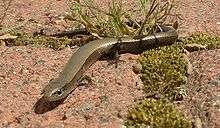Ablepharus
| Ablepharus | |
|---|---|
 | |
| European snake-eyed skink, Ablepharus kitaibelii | |
| Scientific classification | |
| Kingdom: | Animalia |
| Phylum: | Chordata |
| Class: | Reptilia |
| Order: | Squamata |
| Family: | Scincidae |
| Subfamily: | Scincinae |
| Genus: | Ablepharus Bibron & Bory de Saint-Vincent, 1833 |
| Species | |
|
Ablepharus bivittatus | |
Ablepharus is a genus of skinks that contains the common snake-eyed skinks.[1] Their name refers to the fact that their eyelids have fused to a translucent capsule; as in snakes, they thus are physically incapable of blinking.[2] They resemble small lizards and prefer to live in the leaf litter of dry fields and hills.[3] Their scales give them a very shiny, bronze appearance with a characteristically dark stripe down the sides of their bodies. They prey on small insects and other small mollusks.[4]
Characteristics
Appearance
The scales on all Ablepharus species are shiny and bronze in appearance. Also, a very characteristic bronze stripe runs along the length of their bodies. They have short, weak arms which contributes to them moving in a very serpentine-like manner. In general, females are longer and weigh more than their male counterparts. They also have thick tails relative to their body sizes and lengths.[4] Fully mature Ablepharus species can reach up to 15 cm in length. On average, both males and females reach up to about 13 cm in length.[5]
Mannerisms and habitat
As a whole, Ablepharus skinks are generally shy creatures. They tend to bask in the sunlight during the daytime and become more active as dusk and darkness approach.[5] They make their homes in rocky areas with leaf litter and little soil.[6]
Distribution
The geographic range of the common snake-eyed skink spans from southern European countries to northern African countries; also, some species are native to southeast Asia.[5] While most of the species in the genus prefer remaining low to the ground and in drier environments, some species may be found in damper habitats up to 2,000 m above sea level.[4]
Diet
Analysis of the stomach contents of certain Ablepharus species has led to the conclusion that common snake-eyed skinks are typically generalist predators.[6] They mainly feed on small arthropods, mollusks, and small snails.[4]
Lifecycle
In captivity, common snake-eyed skinks are known to survive up to three and a half years; in the wild, where they are preyed upon, they live about two and a half years.[4] Upon reaching reproductive maturity, the female snake-eyed skink lays between two and four eggs at a time; these eggs will then take at least 9 weeks to hatch. Hatchlings typically measure around 3.5 cm long. About two years are needed for the hatchlings to reach reproductive maturity.[4]
Species
Ten species are in the genus:[1]
- A. bivittatus — twin-striped skink
- Found in Azerbaijan, Turkey, south-eastern and central Armenia, Iran, and Turkmenistan
- Typically found in thorny shrubbery, grasslands, and rocky slopes[7]
- A. budaki — Budak's snake-eyed skink
- Found in Turkey, Syria, Lebanon, and Cyprus
- Typically inhabits leaf litter, woodlands, shrubbery, and forests in humid areas[8]
- A. chernovi — Chernov's skink
- Found in Syria, Turkey, and Armenia
- Typically, they are found hiding under leaf litter and small stones in open areas with little shrubbery or forestation. Some may also be found on some of the gentler slopes on some mountain ranges.[9]
- Found in Tajikistan, India, Afghanistan, and Pakistan[10]
- A. deserti — desert lidless skink
- Found in Turkmenistan, Kazakhstan, Uzbekistan, Tajikistan, and Kyrgyzstan
- Generally observed in desert lands and dry slopes with several different types of angiosperms around 2,000 m above sea level[11]
- A. grayanus — minor snake-eyed skink
- Found in Central Asia, Pakistan, India, Afghanistan, and Kyrgyzstan
- Mostly found in the mountainous areas of the regions above
- A. kitaibelii — European snake-eyed skink
- Found in southern Slovakia, Serbia, Hungary, Eastern Croatia, Albania, Greece, southern Romania, Macedonia, and Turkey
- Inhabits arid regions containing meadows, scrubland, and woodland clearings, as well as hilly areas[12]
- A. lindbergi — Lindberg's snake-eyed skink (sometimes A. bivittatus lindbergi)
- Found in western Afghanistan[13]
- A. pannonicus — Asian snake-eyed skink
- Found in the United Arab Emirates, eastern Georgia, Iraq, Iran, Oman, Pakistan, Syria, Jordan, Afghanistan, Caucasus, northwestern India, southwestern Tajikistan, southern Turkmenistan, Kyrgyzstan, Uzbekistan, and western Azerbaijan[14]
- A. rueppellii — Rüppell's snake-eyed skink
- Found in central and northern Israel, the Sinai Peninsula of Egypt, southern Lebanon, western and northern Jordan, and possible reported sightings in Syria and Jordan
- Inhabits more heavily forested areas with dense vegetation, prefer humid areas, especially the oases in Egypt[15]
References
- 1 2 Ablepharus at the Reptarium.cz Reptile Database
- ↑ Orbital Lubrication Hypothesis at the Canadian Journal of Zoology
- ↑ Ablepharus kitaibelii at the IUCN Red List
- 1 2 3 4 5 6 Snake-eyed Skink Archived 2014-12-14 at the Wayback Machine. at the Wildlife Archipelago Archived 2014-12-14 at the Wayback Machine.
- 1 2 3 European Copper Skink at the INaturalist
- 1 2 Ablepharus Microhabitat at the Springer Link
- ↑ Ablepharus bivittatus at the IUCN Redlist
- ↑ Ablepharus budaki at the IUCN Redlist
- ↑ Ablepharus chernovi at the IUCN Redlist
- ↑ Ablepharus darvazi at the Study Room
- ↑ Ablepharus desert at the IUCN Redlist
- ↑ European copper skink at the IUCN Redlist
- ↑ Ablepharus lindbergi at the Reptile Database
- ↑ Ablepharus pannonicus at the Reptile Database
- ↑ Ablepharus rueppellii at the Reptile Database